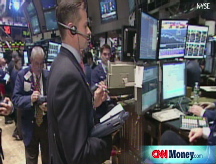Wall Street's Election Day rally
Stocks sizzle as millions of Americans head to the polls. Lending rates ease. Oil prices spike.

NEW YORK (CNNMoney.com) -- Stocks surged Tuesday, with the Dow gaining over 300 points, as millions of Americans battered by the weakened economy turned out to vote for the next President of the United States.
The Dow Jones industrial average (INDU) gained around 305 points, or 3.3%. The Standard & Poor's 500 (SPX) index added 4% and the Nasdaq composite (COMP) rose 3.1%.
"The election has been a source of worry for the market, so you're getting some relief that it's finally here," said Michael Church, senior portfolio manager at Church Capital.
Church said Tuesday's session was also continuing the recent trend of calmer trading, after months of gut-churning volatility.
Stocks rallied last week at the end of one of the worst months in Wall Street history. For the week, the Dow was up 10.1%, the S&P 500 was up 9.5% and the Nasdaq had gained 9.8%.
The rally over the last week and Tuesday may also be signaling the market factoring in a victory for Sen. Barack Obama over Sen. John McCain, said Ken Kam, portfolio manager of the Masters 100 (MOFQX) fund.
Kam said it's not that Wall Street prefers Obama, but it hates uncertainty and is reacting to Obama's expected win.
"When it looks like there is a toss-up, people don't want to take a position," Kam said. "But as it has become clearer that Obama is likely to win, people want to move their money to the areas of the market that will benefit."
Still, stocks will likely get a boost regardless of who wins, analysts say. That's because both candidates represent a new administration and both will have to deal with the battered economy. Also, the incoming president must manage recent government initiatives to stabilize financial markets and get banks lending again.
This week has already brought stark signs of the recession, including dour readings on manufacturing and factory orders, as well as the worst monthly auto sales in 25 years.
While Wall Street would seem to favor Big Business-friendly Republicans, studies show that stocks tend to see bigger returns under a Democratic president. Other studies show stocks do best in times of gridlock - when one party controls the White House and another Congress. That was certainly true in the 1990s. But it hasn't been true in recent years, with a Republican president and a Democratic Congress.
(For more on where McCain stands on key issues, click here. For more on where Obama stands, click here.)
Meanwhile, lending rates continued to improve Tuesday in response to efforts of U.S. and world governments to get money flowing again. Treasury prices inched higher, lowering corresponding yields. Oil prices gained. The dollar was mixed versus other major currencies.
Market breadth was positive. On the New York Stock Exchange, winners trounced losers by more than three to one on volume of 950 million shares. On the New York Stock Exchange, advancers beat decliners nine to five on volume of 2.35 billion shares.
Company news: Financial stocks got a boost from a Wall Street Journal report that the Treasury might buy stakes in a broader range of financial firms, including bond insurers and specialty finance firms such as General Electric's GE Capital Unit and CIT Group.
The Treasury has already used a chunk of the $700 billion rescue fund to buy stakes in troubled banks. GE (GE, Fortune 500) rallied 7.6% and CIT (CIT, Fortune 500) gained 36%.
The stock advance was broad based, with 29 out of 30 Dow stocks rising, led by GE, Caterpillar (CAT, Fortune 500), Chevron (CVX, Fortune 500), Citigroup (C, Fortune 500), American Express (AXP, Fortune 500), Home Depot (HD, Fortune 500) and Verizon Communications (VZ, Fortune 500).
The lone decliner was Hewlett-Packard (HPQ, Fortune 500).
But other large tech stocks advanced, including Dow components Intel (INTC, Fortune 500) and Microsoft (MSFT, Fortune 500), and Nasdaq stocks such as Dell (DELL, Fortune 500), Cisco Systems (CSCO, Fortune 500) and Yahoo (YHOO, Fortune 500).
No big market-moving corporate financial reports were released Tuesday. With roughly 73% of the S&P 500 results out, profits are currently on track to have fallen 11.2% versus a year ago, according to the latest data from tracking firm Thomson Reuters.
Other markets: In global trade, both Asian and European markets ended higher.
The dollar fell against the euro and gained against the yen.
COMEX gold for December delivery climbed $30.50 to settle at $757.30 an ounce.
U.S. light crude oil for December delivery rose $6.62 to settle at $70.53 a barrel on the New York Mercantile Exchange.
Gasoline prices fell another 2.4 cents to a national average of $2.391 a gallon, according to a survey of credit-card activity released Tuesday by motorist group AAA. The decline marks the 48th consecutive day that prices have decreased. During that same time period, prices dropped by $1.46 a gallon, or 37.9%.
Lending rates: The credit market continued to improve, with overnight Libor, a key interbank lending rate, falling to 0.38% from 0.39% Monday, according to Dow Jones. The 3-month Libor fell to 2.71% from 2.86% Monday.
The yield on the 3-month Treasury bill, seen as the safest place to put money in the short term, rose to 0.48% from 0.43% late Monday, with investors preferring to take a small return on their money than risk the stock market. Last month, the 3-month yield reached a 68-year low around 0% as investor panic peaked.
Treasury prices rallied, lowering the yield on the benchmark 10-year note to 3.76% from 3.91% late Monday. Treasury prices and yields move in opposite directions. ![]()





